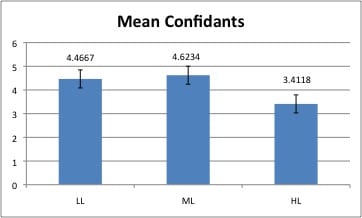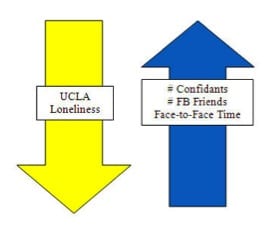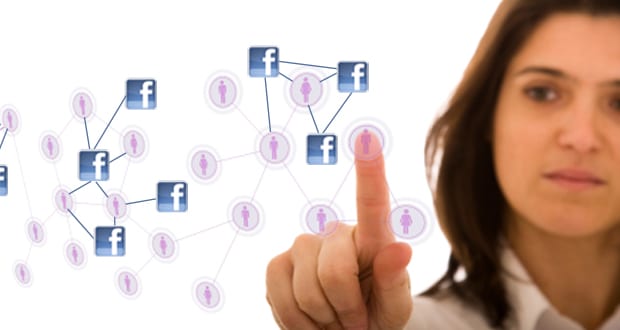Karen Freberg, M.A.
College of Communications and Information
University of Tennessee, Knoxville
Rebecca Adams, B.S.
Department of Psychology
California State University, San Diego
Karen McGaughey, Ph.D.
Statistics Department
California Polytechnic State University, San Luis Obispo
Laura Freberg, Ph.D.
Psychology and Child Development Department
California Polytechnic State University, San Luis Obispo

Abstract:
Interactions between media use and psychological well-being have been described using two major paradigms: a deficiency paradigm that sees individual use of media as a compensation for unsatisfactory face-to-face interactions, and a global use paradigm, in which media use is viewed as universal and therefore parallel to face-to-face behavior (Tsao, 1996). Research into the use of social networking sites (SNSs), such as Facebook, provides opportunities to contrast the predictions of the two paradigms. Comparisons of online and offline connectivity in university students supported the global use paradigm. Students reporting larger numbers of confidants and time spent face-to-face also had the greater number of Facebook friends. Both online and offline connectivity was negatively correlated with subjective loneliness.
Investigations into the correlates of Internet behaviors have their roots in a long history of the use of media and the relationship of that use to human connectivity. For most of our history, connectivity meant face-to-face interaction. Given the fact that our brains have changed little since our time as hunter-gatherers, it is possible that deviations from these face-to-face habits will have significant effects on well-being. Some technological advances have brought people closer together, such as the ability to write a letter to a distant loved one, while others, like the printed word, stimulated a retreat from face-to-face social interaction. Today’s technology habits, especially the use of the Internet and mobile devices, have implications for social interaction that will probably require extensive research to reach full understanding, of which our investigations into Facebook use form only a small part.
Interactions between media use and psychological well-being have been described using two major paradigms: a deficiency paradigm that sees individual use of media as a compensation for unsatisfactory face-to-face interactions, and a global use paradigm, in which media use is viewed as universal and therefore parallel to face-to-face behavior (Tsao, 1996). Research into the use of social networking sites (SNSs), such as Facebook, provides opportunities to contrast the predictions of the two paradigms. Does online social connectivity parallel offline connectivity as predicted by the global use paradigm? Or does the online social environment elicit a different set of social behaviors than the offline social environment, as predicted by the deficiency paradigm?
A critical aspect of psychological well-being is the perception of being socially connected. Without this perception, people experience loneliness (Cacioppo & Patrick, 2008). University students, especially those who are in their first year, are likely to experience significant loneliness as they adjust to their new environment (Cutrona, 1982). These same university students are also likely to use SNSs, and Facebook in particular (Ellison, Steinfield, & Lampe, 2007). The global use paradigm predicts that college students would evidence similar social connectivity in both their virtual and face-to-face environments, whereas the deficiency paradigm predicts that lonely students’ online behavior would reflect efforts to compensate for less than satisfactory face-to-face social connectedness. To examine this issue, we compared patterns of use of the social networking site Facebook with patterns of offline social connectivity.
- Citation
- Authors
 Karen Freberg is a Doctoral Candidate in Communications at the University of Tennessee, Knoxville. Her research interests include social media, reputation management, corporate reputation, crisis management, and risk management. Karen presents frequently at U.S. and international research conferences, including recent conferences in Brazil, the Netherlands, Greece, and China. Karen worked as a public relations intern for Total Media in Cape Town, South Africa with clients in the fashion and consumer industry. She maintains a website www.karenfreberg.com and an award-winning blog on social media and public relations www.karenfreberg.com/blog.
Karen Freberg is a Doctoral Candidate in Communications at the University of Tennessee, Knoxville. Her research interests include social media, reputation management, corporate reputation, crisis management, and risk management. Karen presents frequently at U.S. and international research conferences, including recent conferences in Brazil, the Netherlands, Greece, and China. Karen worked as a public relations intern for Total Media in Cape Town, South Africa with clients in the fashion and consumer industry. She maintains a website www.karenfreberg.com and an award-winning blog on social media and public relations www.karenfreberg.com/blog.
 Karen McGaughey is an assistant professor in Statistics at California Polytechnic State University. Karen received her PhD and MS in Statistics from Kansas State University. Her research interests include statistics education, design of experiments, and design and analysis of computer experiments. While at Cal Poly, Karen took a 3-year leave of absence to pursue professional development opportunities in industry. She worked in research and development at Advanced Micro Devices, Inc. helping engineers to develop and manufacture more advanced microprocessor technologies. She has significant consulting experience working with academic and industry researchers in a variety of fields including psychology, engineering, and agriculture.
Karen McGaughey is an assistant professor in Statistics at California Polytechnic State University. Karen received her PhD and MS in Statistics from Kansas State University. Her research interests include statistics education, design of experiments, and design and analysis of computer experiments. While at Cal Poly, Karen took a 3-year leave of absence to pursue professional development opportunities in industry. She worked in research and development at Advanced Micro Devices, Inc. helping engineers to develop and manufacture more advanced microprocessor technologies. She has significant consulting experience working with academic and industry researchers in a variety of fields including psychology, engineering, and agriculture.
 Laura Freberg, Ph.D. is Professor of Psychology at California Polytechnic State University, San Luis Obispo. She received her Ph.D. from UCLA, with dissertation research conducted at Yale University. Her research interests include technology in the classroom, emerging technologies, and neuroscience. In addition to writing textbooks, including Discovering Biological Psychology and an introductory psychology textbook with co-author John Cacioppo now in production, she maintains a website www.laurafreberg.com and an award-winning blog on psychology www.laurafreberg.com/blog.
Laura Freberg, Ph.D. is Professor of Psychology at California Polytechnic State University, San Luis Obispo. She received her Ph.D. from UCLA, with dissertation research conducted at Yale University. Her research interests include technology in the classroom, emerging technologies, and neuroscience. In addition to writing textbooks, including Discovering Biological Psychology and an introductory psychology textbook with co-author John Cacioppo now in production, she maintains a website www.laurafreberg.com and an award-winning blog on psychology www.laurafreberg.com/blog.
 Rebecca Adams received her B.S. from California Polytechnic State University, San Luis Obispo in 2010 with a major in Psychology and minor in Biology. She is currently a student at San Diego State University, where she is involved in health outcome research. Rebecca plans to pursue a Ph.D. in clinical psychology with an emphasis in health and behavioral medicine.
Rebecca Adams received her B.S. from California Polytechnic State University, San Luis Obispo in 2010 with a major in Psychology and minor in Biology. She is currently a student at San Diego State University, where she is involved in health outcome research. Rebecca plans to pursue a Ph.D. in clinical psychology with an emphasis in health and behavioral medicine.
Positive and Negative Outcomes of Internet Use on Psychological Well-being
Throughout the history of technological developments in media, two dominant and competing paradigms have emerged to explain the relationships between face-to-face interactions and parasocial interactions, such as identifying with a television character or chatting with a stranger online (Tsao, 1996). The deficiency paradigm sees parasocial interaction as a surrogate for face-to-face interactions, which would lead to predictions that the least socially connected would be more likely to use parasocial interactions. In contrast, the global use paradigm suggests that parasocial interaction is a universal human behavior, and the quality and extent of a person’s face-to-face interactions would not predict his or her use of parasocial technologies.The emergence of the Internet as a means of parasocial interaction was followed quickly by a series of negative anecdotal reports. Stoll’s (1995) Silicon Snake Oil decried the effects of this new medium while describing lives ruined by technology. Turkle (1995) argued that players of online role-playing games would neglect their real lives in order to live in the virtual world. Online activity garnered an even more negative reputation following publication of a study by Kraut et al. (1998). These researchers provided families with computers and Internet access. Twelve to 24 months later, the families appeared to have higher rates of depression and loneliness, and lower rates of social involvement. This study exemplified Tsao’s deficiency paradigm, as the authors concluded ‘by using the Internet, people are substituting poorer quality social relationships for better quality relationships’ (Kraut et al., 1998, p. 1029). Subsequent research continued to favor the deficiency paradigm. Nie and Erbring (2002) reported that the amount of time spent on the Internet was negatively correlated with the amount of time spent in face-to-face interactions with family members. Their typical respondent spent 3 hours per day online, which correlated with a 70 minute decrease in the amount of time spent with family members.
Other reports emerged, however, suggesting that the deficiency model might not apply in all cases. In a large Pew Survey (2002), Internet users were found to have larger social networks than those who did not use the Internet. Gross and colleagues (2002, 2004) reported no significant correlations between time spent online and depression, loneliness, anxiety, or perceived friendship. The stereotype of the socially deficient Internet user no longer appeared to be accurate.
Although Gross et al. (2002, 2004) found that Internet time was unrelated to several measures of psychological well-being, a persistent group of heavy Internet users did seem to be having problems. Dittmann (2002) confirmed the Gross et al. findings, but noted that loneliness appeared higher among participants who not only spent a lot of time online (more than 40 hours per week), but preferred online interaction to face-to-face or telephone communications. The heaviest Internet users were more likely to demonstrate shyness, loneliness, and dissociation (Kubey, Lavin, & Barrows, 2001; Ofosu, 2001).
All total, only a few studies out of the body of knowledge regarding the effects of Internet use on psychological well-being demonstrated any negative effects. The majority either showed no effect (Fogel, Albert, Schnabel, Ditkoff, & Neugut, 2003; Franzen, 2000; Gross, 2004; Leung, 2002), or that Internet use was correlated with better well-being (Cheng, Wigand, & Nilan, 2000; Clark, 2002; Fogel, 2002; Sa’adiah, 2002). Some studies even claimed that negative psychological well-being could be improved by Internet use (Shaw & Gant, 2002; White, et al., 2002; White, et al., 1999). These findings are more consistent with Tsao’s global use paradigm, which suggests that Internet use has become a universal experience as opposed to serving as a deliberate strategy for remediating a perceived deficiency. A zero correlation between Internet use and psychological well-being would be expected if people were equally likely to use the Internet regardless of the quality of their current state of well-being.
An additional challenge facing researchers who wish to explore the impact of Internet use is the rapidly changing nature of the technology and the services provided. In the mid to late 1990s, email, gaming, chat rooms, listservs, and information search predominated. Today’s phenomenal growth in social media provides a completely different environment for investigating correlations between psychological well-being and Internet use.
Social Networking Sites (SNSs)
The developing Internet has incorporated aspects of all previous communication technologies (Bargh & McKenna, 2004). People can experience music and video online, much as they have done with radio and television. Online gaming extends the concept of single-player video games, and often incorporates chat as well. Email, chat, and instant messaging provide the rapid, personal communication previously provided by the telephone.
Of all of the technologies currently available, the advent of social networking sites (SNSs) provides one of the most fertile grounds for studying interactions between Internet use and psychological well-being. SNSs have been defined as “web-based services that allow individuals to (1) construct a public or semi-public profile within a bounded system, (2) articulate a list of other users with whom they share a connection, and (3) view and traverse their list of connections and those made by others within the system” (boyd & Ellison, 2008, p. 211). SNSs typically differ from previous online technologies in significant ways. Unlike chat rooms and some email, SNSs are “nonymous” as opposed to anonymous (Zhao, Grasmuck, & Martin, 2008). Use of SNSs generally augments existing social relationships, as opposed to forming new ones (Ellison, et al., 2007).
One of the most popular of the current SNSs is Facebook, launched in 2004 by a Harvard student, Mark Zuckerberg. On most American college campuses, in excess of 90 percent of all undergraduates participate (Lampe, Ellison, & Steinfeld, 2007). Much of the initial research on Facebook and other SNSs has focused on issues of identity presentation and privacy. More recently, researchers have begun to investigate the impact of personality characteristics and self-esteem on Facebook use (Steinfield, Ellison, & Lampe, 2008). However, Ross et al. (2008) suggested that ‘personality defined by the Five-Factor approach may be too broad and not be the best way to understand specific Internet behaviors’ (p. 582). Instead, our research revisits Tsao’s deficiency and global use paradigms in the context of SNS use to discover whether lonely people use this new aspect of the Internet differently than more connected people.
Loneliness
Solitary confinement is among the worst punishments human beings inflict on one another. Social isolation has profound negative effects on health, from reduced lifespan in the fruit fly, Drosophila melanogaster, to decreased anti-inflammatory responses and survival rates in mice following induced stroke (Cacioppo & Hawkley, 2009). Feelings of loneliness might have evolved as a signal to human beings that their social connections are in need of repair (Cacioppo & Patrick, 2008). University students, particularly in their first year, are especially susceptible to feelings of loneliness (Cutrona, 1982).
Previous investigations of the relationships between loneliness and media use suggested that lonely people do attempt to compensate by watching television, listening to radio, reading magazines, or going to a movie (Rokach, 1990; Rook & Peplau, 1982; Schultz & Moore, 1984). However, it remains unclear whether SNSs provide the same respite from loneliness as these more traditional media.
This phenomenon provides researchers with an opportunity to investigate the relationships between student loneliness and their patterns of use of SNSs, and Facebook in particular. If Tsao’s deficiency paradigm holds, we would expect the loneliest students to attempt to compensate for their loneliness through their online interactions. The global use paradigm would predict that obstacles to feeling connected in everyday life may exist in virtual environments as well.
RQ: What relationships exist between loneliness and measures of online and offline connectivity?
Method
Sample and survey administration
A convenience sample of 124 (30 male and 94 female) undergraduate students enrolled in general education psychology courses at a large public university in California served as participants. Participants ranged in age from 18 to 24 years, with a mean age of 19.82 years. Students reported being in their first through sixth years at the university, with a modal response of being in the second year (33.1 percent). Fifty-three percent reported living in an off-campus house or apartment, 44 percent reported living in a campus dormitory, and 2 percent lived at home with parents. Participants reported living with between zero and 8 roommates, with the modal response being 3 (39.5 percent).
Instruments were administered during regular class sessions to volunteers. A single questionnaire assessed demographic variables (age, gender, year in college), questions related to connectivity (living arrangements, number of roommates, club participation, participation in religious services, participation in a committed relationship, number of confidants, time spent face-to-face with friends and family, time spent using phone to communicate with friends and family), participation in the social networking service Facebook (number of friends, number of “close” Facebook friends, site checking, time spent, and services used, e.g. private messages or post photos), and the UCLA Loneliness Scale (Russell, 1996), which was not labeled as such.
Variables of Interest
We were primarily interested in relationships between subjective loneliness, as measured by the UCLA Loneliness Scale, and measures of offline and online social connectivity comprised of face-to-face, phone, and Facebook interactions.
The UCLA Loneliness Scale
Although subsets of the UCLA Loneliness Scale items have been found to be valid and reliable measures of subjective, self-reported loneliness (Stepanikova, Nie, & He, 2010), we used the entire 20-item scale. The resulting Chronbach’s alpha for the scale was .902, which falls within the .89 and .94 range reported by Russell (1996).
Offline Connectivity
A self-report questionnaire assessed several aspects of offline social connectivity typical of university students. Participants reported year in college, as first year students might experience less connectivity than students who had been in residence longer, particularly given our administration of the instrument during the Fall term. Other questions assessed living circumstances (dorm, at home with parents, other off-campus, fraternity/sorority house), number of roommates, number of clubs or organizations of which the participant was a member, frequency of attendance at religious services, and participation in a committed relationship. Participants were asked to indicate their number of confidants, defined in the questionnaire as “people you could tell anything to.”
Participants were asked to estimate the number of times in the past week that they discussed personal issues with a confidant, and how much time they spent in face-to-face interactions with friends and family and communicating with friends and family using a phone. Previous research suggests that global recall measures can provide useful information about socializing activities (Stepanikova et al., 2010).
Online Connectivity
The same self-report questionnaire asked participants to note whether or not they used the SNS Facebook. If so, participants noted the number of friends they listed on their profile, how many of these friends they considered to be “close,” and which services (posting messages, joining groups, learning about events, etc.) they used. Global recall once again was used to ask participants how frequently they check their Facebook site each day, how much time they spend actively on Facebook (as opposed to leaving it running while doing other work or stepping away from the computer), how many times they use Facebook to share very personal information with a close friend, and how much time they spend interacting with close Facebook friends.
Analytic Strategy
Bootstrapping is a type of resampling technique (Simon, 1999) that has recently become more feasible for behavioral scientists due to increasing speed and efficiency of contemporary computers and the inclusion of a bootstrapping module in the PASW18 statistics package. Bootstrapping has particular advantages when the normality of a distribution is unknown or other assumptions required by analytical statistics are unknown. Bootstrapping was used for all statistical analyses conducted in this study.
The influence of demographic variables (gender, age, year in school, etc.) on loneliness was assessed using t-tests and ANOVA. For the purposes of the ANOVA analyses, scores on the UCLA Loneliness Scale were binned as follows (Russell, 1996): scores ≤ 28 represents low loneliness (LL), scores between 29-45 represents medium loneliness (ML), and scores ≥ 46 represent high loneliness (HL). Correlations were computed for measures of offline and online connectivity and loneliness.
Results
The mean score of participants on the UCLA Loneliness Scale was 37.78, which falls in the range of medium loneliness, and is consistent with previous findings among university students. Russell (1996) reported a mean of 40.08 from his sample of 487 undergraduates at another public university in California. Using the binning criteria listed above, 17 participants (15 percent) were in the HL group, 79 (70 percent) were in the ML group, and 17 (15 percent) were in the LL group. Eleven participants did not complete the entire UCLA Loneliness Scale and were excluded from further analysis.
The vast majority of our participants (95 percent) reported being active participants on Facebook. Unlike results reported by Russell (1996), the current sample did not differ in loneliness based on gender (t = .637, d.f. = 121, p = .525). In addition to gender, other demographic variables showed no significant relationships with loneliness: age (F = .600, d.f. = 6, 115, p = .730), year in school (F = 1.224, d.f. = 5, 117, p = .302), participation in a committed relationship (t = -1.334, d.f. = 121, p = .185), attendance at religious services (F = .494, d.f. = 3, 199, p = .687), participation in clubs and organizations (F = .780, d.f.= 2, 120, p =.461), living arrangements (F =2.503, d.f. = 2, 120, p = .086), number of roommates (F = 1.427, d.f. = 2, 120, p = .244), and number of Facebook services used (e.g. private messaging, chat, posting photos, etc.; F = .174, d.f. = 2, 120, p = .841).

Table 1. UCLA Loneliness Scores as a function of demographic variables.
We assessed several variables related to social connectivity, including self-reported numbers of confidants, total number of Facebook friends, and number of “close” Facebook friends. Participants reported having between 1 and 15 confidants, with a mean of 4.38, between 15 and 1100 Facebook friends, with a mean of 374.91, and between 1 and 75 “close” Facebook friends, with a mean of 14.5. The number of confidants was significantly correlated with the number of total Facebook friends (Spearman’s rho = .213, p < .05) and the number of “close” Facebook friends (Spearman’s rho = .386, p < .001). Reported numbers of total and close Facebook friends were significantly correlated (Spearman’s rho = .429, p < .001). Scores on the UCLA Loneliness Scale were significantly and negatively correlated with number of confidants (Spearman’s rho = -.232, p < .05) and total number of Facebook friends (Spearman’s rho = -.282, p < .01), but not with the number of “close” Facebook friends (Spearman’s rho = -.123, p = .204) or with the ratio of “close” to total Facebook friends (Spearman’s rho = .042, p = .665).

Figure 1. Mean number of reported confidants as a function of low loneliness (LL), medium loneliness (ML), or high loneliness (HL) as measured by the UCLA Loneliness Scale (Russell, 1996).

Figure 2. Mean number of reported Facebook friends as a function of low loneliness (LL), medium loneliness (ML), or high loneliness (HL) as measured by the UCLA Loneliness Scale (Russell, 1996).

Figure 3. Scores on the UCLA Loneliness Scale (Russell, 1996) were negatively correlated with reported numbers of confidants, Facebook friends, and time spent interacting with others face-to-face.
UCLA Loneliness scores were evaluated as a function of reported time spent face-to-face with friends and family, time spent communicating with friends and family using a phone, and time spent on Facebook. Participants reported spending an average of 6.17 hours per day in face-to-face interactions with friends or family members and an average of 1.37 hours per day communicating with friends and family using a phone. They reported spending an average of just under one hour per day (.8953 hours) actively using Facebook. UCLA Loneliness scores were significantly and negatively correlated with face-to-face time (Spearman’s rho = -.236, p < .05), but were not correlated with either time spent on using a phone (Spearman’s rho = -.173, p = .068) or Facebook (Spearman’s rho = -.076, p = .427).

Table 2. Measures of online and offline connectedness as a function of UCLA Loneliness scores.
Discussion
Parallel to findings reported by Cutrona (1982) and Russell (1996), university students in the current study reported a significant degree of loneliness, with only 17 percent of participants having “low” loneliness and the mean (37.78) falling in the “moderate” range. Consequently, university students continue to be at significant risk for the negative physical and psychological outcomes of loneliness (Cacioppo & Patrick, 2008).
Consistent with previous reports, the vast majority (95 percent) of the current participants reported being actively involved with Facebook (Ellison, Steinfield, & Lampe, 2007). The high levels of SNS use among college students might represent efforts to maintain “social capital,” defined as the resources obtained through relationships with other people (Coleman, 1988), by remaining connected with pre-existing networks of friends and family (Ellison, Steinfield, & Lampe, 2007). Loneliness did not significantly affect the likelihood of participation on Facebook (X2 = 6.48, d.f. = 4, p = .166). Of the six participants who reported no current, active participation in Facebook, none were in the LL group, 3 were in the ML group, and 3 were in the HL group. The non-using ML participants represented only 4 percent of the ML group, whereas the non-using HL participants represented 18 percent of the HL group. Given the very small numbers of non-participants, larger samples might illuminate this relationship further.
Loneliness was related to several indicators of offline social connectedness assessed in this study, including number of confidants and time spent face-to-face with friends and family. Russell (1996) reported significant negative correlations between the number and quality of relationships reported by his elderly participants and their scores on the UCLA Loneliness Scale. McPherson, Smith-Lovin, and Brashears (2006) reported that in 2004, Americans were three times as likely to report having no one with whom to discuss important matters as in 1985. The mode in 1985 was three confidants, whereas the mode in 2004 was zero. Clearly, as a culture, we are moving in a direction of being less connected. The current university participants fared somewhat better than Americans as a whole. Their mean number of reported confidants was 4.38 and the mode was 3 confidants. It would be refreshing to think that the connectedness provided by SNSs such as Facebook might reverse the trends observed by McPherson, Smith-Lovin, and Brashears (2006), but this might also be an age-related variable. It is possible that younger people would report more confidants than the population as a whole, given their proximity to parents and siblings. Reported numbers of confidants was negatively correlated with UCLA Loneliness scores. Further research will be necessary to determine whether a failure to establish relationships with confidants increases loneliness, or whether feelings of loneliness disrupt a person’s connectivity with potential confidants. Time reported spent in face-to-face interactions with friends and family was also negatively correlated with loneliness, but time spent communicating via phone was not.
An online parallel to the confidants measure was our question about participants’ numbers of Facebook friends. SNSs like Facebook are unique in that people typically interact with people they have met offline rather than using the technology to meet new people, as was the case in most chat rooms (Ellison, Steinfield, & Lampe, 2007). However, a ‘friend’ on an SNS might be defined more broadly than the usual use of the word (Tong, Van der Heide, Langwell, & Walther, 2008). We wanted to see if a person’s self-reported number of Facebook friends would show the same correlations with loneliness as the offline measures of confidantes. This did turn out to be the case, as a significant negative correlation was found between loneliness scores and number of self-reported friends. These findings suggest that many of the obstacles to feeling connected in everyday life exist in online social communities as well.
Evolutionary psychologists have suggested that social networks are a regular function of neocortical capacity, and that the limit on human social networks is 150 connections, or the so-called “Dunbar’s number” (Hill & Dunbar, 2003). Although our student sample reported a mean number of Facebook friends well outside this limit (374.91), it is interesting to note that overall, the average Facebook user’s number of friends is 130 (Facebook, 2010). It is also interesting to note that ratios of confidants to Dunbar’s number (4:150 or .03) are quite similar to the ratios between our participants’ reported close and total Facebook friends (14.5:374 or .038). Although speculative at this point, these similarities suggest that human beings have an underlying sociability that is expressed regardless of medium.
Conclusions
We began our investigation with the question of whether participation in SNSs such as Facebook fits the expectations of Tsao’s deficiency or global use paradigms more closely. Given the finding of parallel loneliness in both online and offline domains, it appears that the global use paradigm is more appropriate for understanding SNS participants. The most lonely participants do not appear to be finding more ‘friends’ online as a means of compensating for their real-world experiences. Quite the opposite is true. In addition, the overwhelming quantity of SNS use among college students is more consistent with the global use paradigm, which sees Internet use as universal, as opposed to a realm inhabited by people who are somehow different than non-users.
It is likely that the “nonymous” aspect of Facebook and other SNSs contributes to the similarities between online and offline social connectedness observed in the current study, and that participation in anonymous venues, like chat rooms, might not produce the same outcomes. It is becoming increasingly important to distinguish between “time spent online” and the types of online activities in which people engage in their time online, as these seem to have quite diverse relationships with measures of psychological well-being, including loneliness. Irena Stepanikova and her colleagues (2010) reported that increased loneliness and reduced life satisfaction were all particularly correlated with large amounts of time spent on instant messaging (IM), chat rooms, and newsgroups, all of which can be accessed anonymously.
Limitations and Future Research
The current investigation was limited by its convenience sample of university students as well as our inability to ask additional follow-up questions to the items in our questionnaire. These limitations can be addressed by future research incorporating more representative samples, individual interviews, and focus groups.
Although widely used in the psychological literature, self-report data can be subject to distortion. Future research on SNSs could incorporate “checks” of actual numbers of friends and the use of diary methods to confirm time spent in online and offline socialization (Stepanikova, et al., 2010).
References
Bargh, J. A., & McKenna, K. Y. A. (2004). The Internet and social life. Annual Review of Psychology, 55, 573-590.
boyd, d. m., & Ellison, N. B. (2008). Social network sites: Definition, history, and scholarship. Journal of Computer-Mediated Communication, 13, 210-230.
Cacioppo, J. T., & Hawkley, L. C. (2009). Perceived social isolation and cognition. Trends in Cognitive Sciences, 13(10), 447-454. doi: 10.1016/j.tics.2009.06.005
Cacioppo, J. T., & Patrick, W. (2008). Loneliness: Human nature and the need for social connection. New York: Norton.
Cheng, H., Wigand, R. T., & Nilan, M. (2000). Exploring Web users’ optimal flow experiences. Information Technology & People, 13(4), 263-281.
Clark, M. J. (2002). Older adults living through and with their computers. Cin-Computers Informatics Nursing, 20(3), 117-124.
Coleman, J. C. (1988). Social capital in the creation of human capital. American Journal of Sociology, 94, S95-S120.
Cutrona, C. E. (1982). Transition to college: Loneliness and the process of social adjustment. In L. A. Peplau & D. Perlman (Eds.), Loneliness: A sourcebook of current theory, research and therapy (pp. 291-309). New York: Wiley.
Dittmann, K. L. (2004). A study of the relationship between loneliness and Internet use among university students. Dissertation Abstracts International: Section B: The Sciences & Engineering, 64(7-B), 3518.
Ellison, N. B., Steinfield, C., & Lampe, C. (2007). The benefits of Facebook “friends:” Social capital and college students’ use of online social network sites. Journal of Computer-Mediated Communication, 12, 1143-1168.
Facebook. (2010). Press room: Statistics. Retrieved August 23, 2010, from http://www.facebook.com/press/info.php?statistics
Fogel, J. (2002). Internet use and social support in women with breast cancer. Health Psychology, 21(4), 398-404.
Fogel, J., Albert, S. M., Schnabel, F., Ditkoff, B. A., & Neugut, A. I. (2003). Racial/ethnic differences and potential psychological benefits in use of the Internet by women with breast cancer. Psycho-oncology, 12(2), 107-117.
Franzen, A. (2000). Does the Internet make us lonely? European Sociological Review, 16(4), 427-438.
Gross, E. F. (2004). Adolescent Internet use: What we expect, what teens report. Journal of Applied Developmental Psychology, 25(6), 633-649.
Gross, E. F., Juvonen, J., & Gable, S. L. (2002). Internet use and well-being in adolescence. Journal of Social Issues, 58(1), 75-90.
Hill, R. A., & Dunbar, R. I. M. (2003). Social network size in humans. Human Nature, 14(1), 53-72.
Kraut, P., M., P., Lundmark, V., Kiesler, S., Mukopadhyay, T., & Scherlis, W. (1998). Internet paradox: A social technology that reduces social involvement and psychological well-being? American Psychologist, 53, 65-77.
Kubey, R. W., Lavin, M. J., & Barrows, J. R. (2001). Internet use and collegiate academic performance decrements: Early findings. Journal of Communication, 51(2), 366-382.
Lampe, C., Ellison, N., & Steinfeld, C. (2007). A familiar Face(book): Profile elements as signals in an online social network Proceedings of Conference on Human Factors in Computing Systems (pp. 435-444). New York: ACM Press.
Leung, L. (2002). Loneliness, self-disclosure, and ICQ use. CyberPsychology & Behavior, 5(3), 241-251.
McPherson, M., Smith-Lovin, L., & Brashears, M. T. (2006). Social isolation in America: Changes in core discussion networks over two decades. American Sociological Review, 71, 353-375.
Nie, N. H., & Erbring, L. (2002). Internet and society: a preliminary report. IT & Society, 1(1), 275-283.
Ofosu, H. B. (2001). Heavy Internet use: A proxy for social interaction. Dissertation Abstracts International: Section B: The Sciences & Engineering., 61(9-B), 5058.
Pew Internet & American Life. (2006). The strength of Internet ties. Retrieved May 1, 2006, from http://www.pewInternet.org/pdfs/PIP_Internet_ties.pdf
Rokach, A. (1990). Surviving and coping with loneliness. Journal of Psychology: Interdisciplinary and Applied, 124(1), 39-54.
Rook, K. S., & Peplau, L. A. (1982). Perspectives on helping the lonely. In L. A. Peplau & D. Perlman (Eds.), Loneliness: A sourcebook of current theory, research and therapy (pp. 351-378). New York: Wiley.
Ross, C., Orr, E. S., Sisic, M., Arseneault, J. M., Simmering, M. G., & Orr, R. R. (2008). Personality and motivations associated with Facebook use. Computers in Human Behavior, 25, 578-587.
Russell, D. (1996). The UCLA Loneliness Scale (Version 3): Reliability, validity, and factor structure. Journal of Personality Assessment, 66, 20-40.
Sa’adiah, R. (2002). The Internet as a means for promoting the recovery and empowerment of people with mental health problems. Israel Journal of Psychiatry & Related Sciences, 39(3), 192-193.
Schultz, N. R., & Moore, D. (1984). Loneliness: Correlates, attributions, and coping among older adults. Personality and Social Psychology Bulletin, 10(1), 67-77. doi: 10.1177/0146167284101007
Shaw, L. H., & Gant, L. M. (2002). In defense of the Internet: The relationship between Internet communication and depression, loneliness, self-esteem, and perceived social support. support.’ Cyberpsychology & Behavior, 5(2), 157-171.
Simon, J. L. (1999). Resampling: The new statistics. Arlington, VA: Resampling Stats.
Steinfield, C., Ellison, N. B., & Lampe, C. (2008). Social capital, self-esteem, and use of online social network sites: A longitudinal analysis. Journal of Applied Developmental Psychology, 29, 434-445.
Stepanikova, I., Nie, N. H., & He, X. (2010). Time on the Internet at home, loneliness, and life satisfaction: Evidence from panel time-diary data. Computers in Human Behavior, 26(3), 329-338. doi: DOI: 10.1016/j.chb.2009.11.002
Stoll, C. (1995). Silicon snake oil. New York: Doubleday.
Tong, S. T., Van der Heide, B., Langwell, L., & Walther, J. B. (2008). Too much of a good thing? The relationship between number of friends and interpersonal impressions on Facebook. Journal of Computer-Mediated Communication, 13, 531-479.
Tsao, J. (1996). Compensatory media use: An exploration of two paradigms. Communication Studies, 47, 89-199.
Turkle, C. (1996). Virtuality and its discontent: searching for community in cyberspace. The American Prospect, 24, 50-57.
White, H., McConnell, E., Clipp, E., Branch, L. G., Sloane, R., Pieper, C., et al. (2002). A randomized controlled trial of the psychosocial impact of providing Internet training and access to older adults. Aging & Mental Health, 6(3), 213-221.
White, H., McConnell, E., Clipp, E., Bynum, L., Teague, C., Navas, L., et al. (1999). Surfing the net in later life: A review of the literature and pilot study of computer use and quality of life. Journal of Applied Gerontology, 18(3), 358-378.
Zhao, S., Grasmuck, S., & Martin, J. (2008). Identity construction on Facebook: Digital empowerment in anchored relationships. Computers in Human Behavior, 24, 1816-1836.
 Media Psychology Review Journal for Media Psychology
Media Psychology Review Journal for Media Psychology
